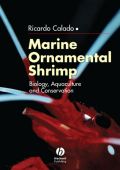
Marine Ornamental Shrimp provides a global overview of the biology, culture, and conservation of the major families of marine ornamental shrimp. Coverage in this thorough volume includes ecological aspects, reproductive biology, major techniques used in culture systems for maturation, larviculture, and juvenile growth, and details of the main conservation issues surrounding these important species, including a discussion of the negative aspects of wild specimen collection and the ongoing efforts to mitigate such impacts. INDICE: Chapter 1.Introduction (what is a marine ornamental shrimp?).This first chapter will provide an overview on marine ornamental shrimp, namely thefeatures displayed by the species that made them suitable for the marine aquarium trade. This chapter can help recruiting new species to the trade, and will emphasize the importance of addressing in the advance the culture potential of such species.Chapter 2.Collected and traded species.This chapter presents alist of marine ornamental shrimp species commonly available in the trade, their distribution area and particular features that make them so prized in the marine aquarium industry.Chapter 3.Ecological remarks.The relevant aspects of the ecology of the most heavily collected and/or popular shrimp species will bedescribed, namely their habitat, symbiotic relations and fish cleaning behavior..Chapter 4.Reproductive biology and mating behavior.This chapter will focusthe sexual systems of marine ornamental shrimp species, sexual dimorphism andmating, with emphasis on the agonistic behaviors of some species towards conspecifics.Chapter 5.Larval development.The most distinct larval features of marine ornamental shrimp will be described in this chapter, highlighting the potential displayed by some species to delay metamorphosis when facing unfavorableconditions. The role of settlement cues to trigger metamorphosis and larval adaptations to avoid predation will also be addressed.Chapter 6.Broodstock maintenance in captivity.This chapter addresses how gonad maturation and embryo production can be induced in breeding pairs of marine ornamental shrimp kept in captivity. Maturation systems, diets and offspring quality will be the main topics, with currently available protocols on these issues being addressed in detail.Chapter 7.Larval culture.Currently considered the bottleneck still impairing commercial scale production of some species, several aspects related to larval culture will be discussed in this chapter. The main topics will be the suitability of larval rearing systems, live and inert larval diets, stocking densities, early and late larval stage mortality and ability to delay metamorphosis.Chapter 8.Juvenile culture.This chapter will discuss the protocols currently established to raise juvenile marine ornamental shrimp. Grow-out systems, dietary needs and stocking procedures will be analyzed in detail.Chapter 9.Othermarine ornamental decapod species with culture potential.The culture potential and profitability of marine ornamental hermit crabs, true crabs and lobsterswill be focused in this chapter. Culture protocols currently available for these organisms will be discussed.Chapter 10.Future improvements on marine ornamental shrimp culture.This chapter will discuss the future directions for marine ornamental shrimp culture, namely how can current bottlenecks be solved. Thehighlights of this chapter will be which new approaches are being tested, namely the use of alternative live and inert larval diets, mesocosms culture, andthe potential use of late larval stages collected from the wild and raised incaptivity to marketable size.Chapter 11.Conservation issues.The direct and indirect negative impacts that can be associated to the collection of marine ornamental shrimp from their habitat, namely coral reefs, are discussed in this chapter. Mitigation measures are discussed and the role that cultured specimenscan have in reducing the pressure in wild populations is highlighted.Chapter 12.Conclusions.The highlights of each chapter will be summarized in this finalchapter and some important guidelines for further studies on marine ornamental shrimp will be addressed, namely the need to perform further ecological studies on the most heavily collected species, to ascertain the real impacts of ornamental shrimp harvest and the diffusion of established culture protocols to increase the offer of cultured specimens in the aquarium trade.
- ISBN: 978-1-4051-7086-4
- Editorial: Blackwell
- Encuadernacion: Cartoné
- Páginas: 280
- Fecha Publicación: 31/07/2008
- Nº Volúmenes: 1
- Idioma: Inglés
